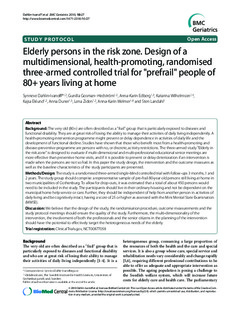| dc.contributor.author | Dahlin-Ivanoff, S. | |
| dc.contributor.author | Gosman-Hedström, G. | |
| dc.contributor.author | Edberg, A.-K. | |
| dc.contributor.author | Wilhelmson, K. | |
| dc.contributor.author | Eklund, K. | |
| dc.contributor.author | Duner, A. | |
| dc.contributor.author | Landahl, S. | |
| dc.date.accessioned | 2018-01-16T13:43:07Z | |
| dc.date.available | 2018-01-16T13:43:07Z | |
| dc.date.issued | 2010 | |
| dc.identifier.citation | Dahlin-Ivanoff, S., Gosman-Hedström, G., Edberg, A.-K., Wilhelmson, K., Eklund, K., Duner, A., . . . Landahl, S. (2010) Elderly persons in the risk zone. Design of a multidimensional, health-promoting, randomised three-armed controlled trial for "prefrail" people of 80+ years living at home. BMC Geriatrics, 10, 27. | nb_NO |
| dc.identifier.uri | http://hdl.handle.net/11250/2477823 | |
| dc.description.abstract | Background The very old (80+) are often described as a "frail" group that is particularly exposed to diseases and functional disability. They are at great risk of losing the ability to manage their activities of daily living independently. A health-promoting intervention programme might prevent or delay dependence in activities of daily life and the development of functional decline. Studies have shown that those who benefit most from a health-promoting and disease-preventive programme are persons with no, or discrete, activity restrictions. The three-armed study "Elderly in the risk zone" is designed to evaluate if multi-dimensional and multi-professional educational senior meetings are more effective than preventive home visits, and if it is possible to prevent or delay deterioration if an intervention is made when the persons are not so frail. In this paper the study design, the intervention and the outcome measures as well as the baseline characteristics of the study participants are presented. Methods/Design The study is a randomised three-armed single-blind controlled trial with follow-ups 3 months, 1 and 2 years. The study group should comprise a representative sample of pre-frail 80-year old persons still living at home in two municipalities of Gothenburg. To allow for drop-outs, it was estimated that a total of about 450 persons would need to be included in the study. The participants should live in their ordinary housing and not be dependent on the municipal home help service or care. Further, they should be independent of help from another person in activities of daily living and be cognitively intact, having a score of 25 or higher as assessed with the Mini Mental State Examination (MMSE). Discussion We believe that the design of the study, the randomisation procedure, outcome measurements and the study protocol meetings should ensure the quality of the study. Furthermore, the multi-dimensionality of the intervention, the involvement of both the professionals and the senior citizens in the planning of the
intervention should have the potential to effectively target the heterogeneous needs of the
elderly. Trial registration ClinicalTrials.gov, NCT00877058 | nb_NO |
| dc.publisher | BMC Geriatrics | nb_NO |
| dc.rights | Navngivelse 4.0 Internasjonal | * |
| dc.rights.uri | http://creativecommons.org/licenses/by/4.0/deed.no | * |
| dc.subject | health-promoting intervention programme | nb_NO |
| dc.subject | functional decline | nb_NO |
| dc.subject | Elderly in the risk zone | nb_NO |
| dc.subject | educational senior meetings | nb_NO |
| dc.subject | professionals | nb_NO |
| dc.subject | senior citizens | nb_NO |
| dc.title | Elderly persons in the risk zone. Design of a multidimensional, health-promoting, randomised three-armed controlled trial for "prefrail" people of 80+ years living at home | nb_NO |
| dc.type | Journal article | nb_NO |
| dc.source.volume | 10 | nb_NO |
| dc.source.journal | BMC Geriatrics | nb_NO |
| dc.source.issue | 27 | nb_NO |
| dc.identifier.doi | https://doi.org/10.1186/1471-2318-10-27 | |

